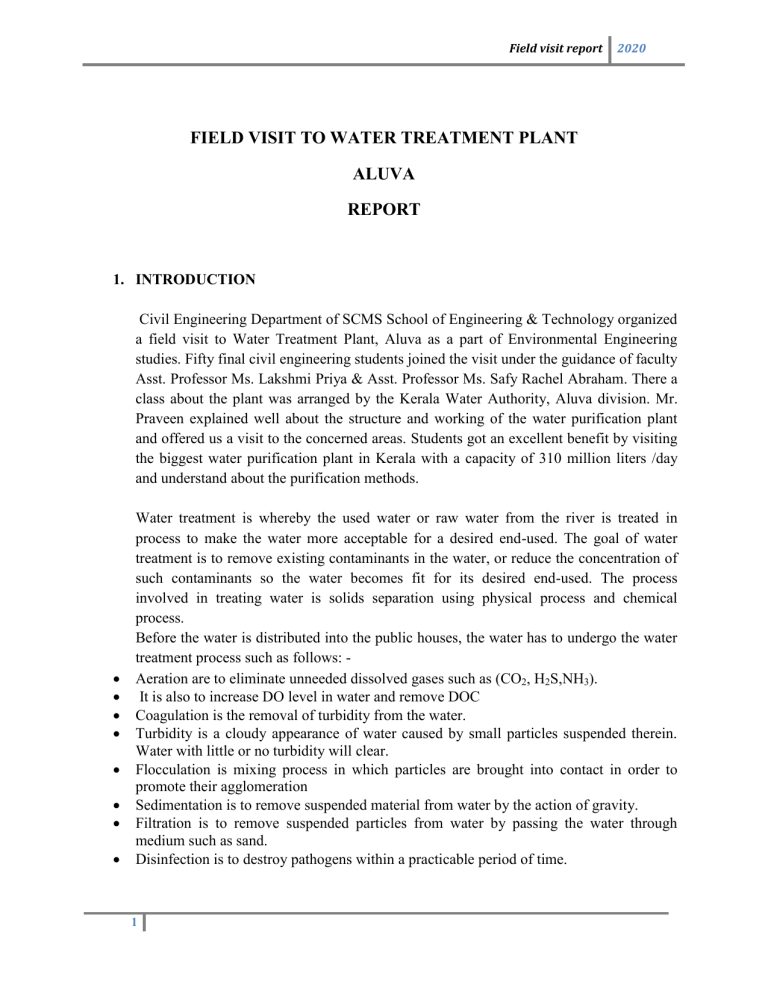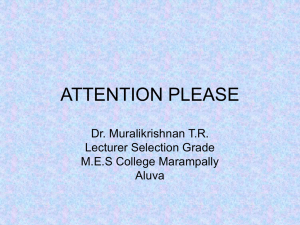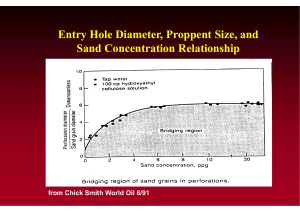
Field visit report 2020 FIELD VISIT TO WATER TREATMENT PLANT ALUVA REPORT 1. INTRODUCTION Civil Engineering Department of SCMS School of Engineering & Technology organized a field visit to Water Treatment Plant, Aluva as a part of Environmental Engineering studies. Fifty final civil engineering students joined the visit under the guidance of faculty Asst. Professor Ms. Lakshmi Priya & Asst. Professor Ms. Safy Rachel Abraham. There a class about the plant was arranged by the Kerala Water Authority, Aluva division. Mr. Praveen explained well about the structure and working of the water purification plant and offered us a visit to the concerned areas. Students got an excellent benefit by visiting the biggest water purification plant in Kerala with a capacity of 310 million liters /day and understand about the purification methods. Water treatment is whereby the used water or raw water from the river is treated in process to make the water more acceptable for a desired end-used. The goal of water treatment is to remove existing contaminants in the water, or reduce the concentration of such contaminants so the water becomes fit for its desired end-used. The process involved in treating water is solids separation using physical process and chemical process. Before the water is distributed into the public houses, the water has to undergo the water treatment process such as follows: Aeration are to eliminate unneeded dissolved gases such as (CO2, H2S,NH3). It is also to increase DO level in water and remove DOC Coagulation is the removal of turbidity from the water. Turbidity is a cloudy appearance of water caused by small particles suspended therein. Water with little or no turbidity will clear. Flocculation is mixing process in which particles are brought into contact in order to promote their agglomeration Sedimentation is to remove suspended material from water by the action of gravity. Filtration is to remove suspended particles from water by passing the water through medium such as sand. Disinfection is to destroy pathogens within a practicable period of time. 1 Field visit report 2020 Water distribution is to satisfy the water requirements for a combination of domestic, commercial, industrial and fire-fighting purposes. After water passes or flowing through all distinctive features, it’s collected into water tank and ready to be supply to houses area. Fig.1.1.Flowchart of water treatment palnt 2. OBJECTIVE The objectives of visiting the water treatment plant are: To study the types of water treatment plant used. To study the process of water treatment. 2 Field visit report 2020 3. WATER TREATMENT PROCESS i. COLLECTION:The raw water which is supplied to the water treatment plant comes from periyar river. ii. COAGULATION:The raw water is first treated with chemical coagulant alum. The dose of alum varies depending upon the turbidity, color, temperature & pH of the water. iii. FLASH MIXING:Treated water is then subjected to violent agitation in a mixing chamber for a few minutes. This allows quick and rapid dissemination of alum throughout the bulk of the water. Fig.3.1.Flash mixing 3 Field visit report iv. 2020 FLOCCULATION:This phase involves a slow and gentle stirring of the treated water in a flocculation chamber. The mechanized type of rotor is used. This causes the formation of thick copious white flocculent precipitate. The thicker the precipitate is, the higher is the settling velocity. Fig.3.2 Clariflocculator 4 v. SEDIMENTATION:-The coagulated water is now lead into sedimentation tank where it is detained for 2-6 hrs when the flocculent precipitate together with impurities and bacteria settle down in the tank. -At least 95% of the flocculent precipitate needs to be removed from the water before it is admitted to the rapid filters. vi. FILTERATION:-Each filter unit has 6 sand beds – coarse pebble, fine pebble, coarse gravel, fine gravel, coarse sand, fine sand. -The thickness of sand bed is 110 cm. -The under drains at the bottom of the filter bed collects the filter water. Field visit report 2020 -Sandfilters getting dirty and beginning to lose efficiency approaching 7-8 feet needing, backwashing. Fig.3.3. Sand filtration bed vii. BACKWASHING :-As filter proceeds, the suspended impurities and bacteria clog the filters. -The filter soon becomes dirty and begin to lose their efficiency and are subjected to backwashing. -This is done by reversing the flow of water through the sand bed. -Washing is stopped when clear sand is visible and the wash water is sufficiently clean. -It takes about 15 minutes. viii. DISINFECTION :-This is the last step before storage and distribution of this water. -The process used is chlorination. -The chlorine gas is used for effective disinfection. ix. 5 RESERVOIR :-We have visited the reservoir where the purified water was stored. -From there it was supplied to various parts of Ernakulam and Aluva. Field visit report 2020 4. CONCLUSION Water plays a very important role in human life, whether for daily routine purpose or human health. This field visit gave us the knowledge about the purification of water on large scale and made us aware about the quality of water since it may affect the human health especially. Also the trip made us realized that it is not easy to supply the water directly from the main supply to the people. Thus, thanks to the responsible party and the workers who invested in this project to ensure the health and convenience of the people in Aluva and Ernakulam and the faculties for planning this event smoothly. Fig.4. SSET S8 CE-2 students 6






